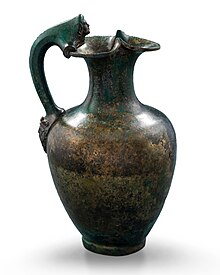| Oenochoe | |
|---|---|
| οἰνοχόη | |
 Terracotta trefoil oenochoe, Wild Goat style, c. 625 BC – 600 BC, in the Louvre. Below: bronze trefoil-mouthed oenochoe with Dionysus head on handle attachment, 330–320 BC, part of the Vassil Bojkov collection, Sofia, Bulgaria. | |
 | |
| Material | Mainly terracotta, rarely metals, stone, and later glass |
| Size | Typically 25 centimetres (9.8 in) or less in height |
| Writing | None in the Bronze Age, illustration names of depicted scenes in classical times |
| Classification | Oenochoe, "wine pourer" |
| Culture | Cross-cultural in Mediterranean civilizations |
An oenochoe, also spelled oinochoe (Ancient Greek: οἰνοχόη; from Ancient Greek: οἶνος, oînos, "wine", and Ancient Greek: χέω, khéō, lit. 'I pour', sense "wine pourer"; pl.: oinochoai; Neo-Latin: oenochoë, pl.: oenochoae; English pl.: oenochoes or oinochoes), is a wine jug and a key form of ancient Greek pottery.
Intermediate between a pithos (large storage vessel) or amphora (transport vessel), and individual cups or bowls, it held fluid for several persons temporarily until it could be poured. The term oinos (Linear B: "wo-no") appears in Mycenaean Greek, but not the compound. The characteristic form was popular throughout the Bronze Age, especially at prehistoric Troy. In classical times for the most part the term oinochoe implied the distribution of wine. As the word began to diversify in meaning, the shape became a more important identifier than the word. The oinochoe could pour any fluid, not just wine. The English word, pitcher, is perhaps the closest in function.